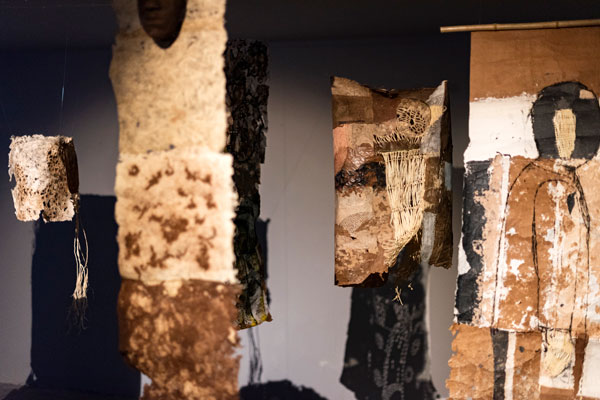Prime
Ugandan artist finds purpose in blending folk material

What you need to know:
- Nakitende is currently exhibiting her works at the Gallery Brulhart in Geneva, Switzerland along with Dr Gindi. The showcase is titled ‘She That Spreads the Winds’, a piece depicting a twisting figure seemingly caught in a vortex of swirling winds.
Sheila Nakitende is inspired by things that are relatable, with her culture the biggest source of pride. Nakitende’s creativity is easily traceable in titles of her work such as l her sculptural 2022 installation—Abaana Ba Kintu.
She showcased her ingenuity with backcloth, an aesthetically important and renewable material, by repurposing it to make it relevant in a contemporary world. While at it, she invited audiences to share their views of the 600-year-old material.
The works from Abaana Ba Kintu were exhibited at the Department of Chemistry at Makerere University by Nakitende. The 40-year-old majored in oil painting and fashion design at art school, but has unboxed her creative juices to flow in more areas by focusing on material culture and transformation as a multidisciplinary artist. She is defined by her indefinite versatility in the areas of painting, sculpture, interior designing as well as set designing for film and production.
“I love to challenge myself when I am presented with opportunities and face them with the skills I have,” she says.
Nakitende is currently exhibiting her works at the Gallery Brulhart in Geneva, Switzerland along with Dr Gindi. The showcase is titled ‘She That Spreads the Winds’, a piece depicting a twisting figure seemingly caught in a vortex of swirling winds.
“It was interesting how the selectors got interested in our work. We are both sculptors. We were put together because of the way our materials are created from the backcloth,” she notes, adding, “When the idea was proposed of us having a duo exhibition, I was very happy. Dr Gindi is from a different nation and also from a different generation, which excites me.”
Their work is in very close conversation. The title itself dovetails with Nakitende’s personality and the things she tackles as a woman. “I work so much metaphorically. I could be talking about something, but I use symbols. Wind is something you can’t see. It’s a force of nature. You can only know about wind by what it does. Many times, I look at myself as wind because it can be.”
The two artists tackle the themes of spirituality, humanity, environment and female personalities. In its observation, the gallery describes Nakitende’s work as a meditative process of harvesting the bark and reshaping it into fleece. The gallery adds that Nakitende weaves emotion and air into her pieces as she echoes Dr Gindi’s idea of breaking down of the human psyche, casting it through wax and rebuilding it as filigree of sturdy bronze.
The two artists are brought together in an incarnation of human resilience, and transcendence. The iterative process examines and dismantles emotion and materials in order to capture their form. Nakitende’s work goes beyond the obvious representation and into depths of ideas. This after taking interest in materials and cultural objects like fibres, baskets, backcloth, raffia and banana fibres.
Mood boards from her university days relay a journey that shows cultural elements, traditional guards, the shields, the mats, and so on.She was drawn to those materials and didn’t know how she could use them.

But she tried many ideas and purposely used them as a source of inspiration and imagination. Many people who observed her creative processes were surprised at her resilience to use materials seen for their traditional practices.
The artist was convinced that there was an opportunity to use the materials in a contemporary context to find value in modern spaces: traditional and modernity can be fused to share space.
Evidence is there to see with international acclaimed brands like Puma and Mercedes Benz using backcloths in beautifying their products. This motivates Nakitende whose production process with backcloth can be traced back to her grandfather’s influence.
It is mostly likely for the reason that she chose the curatorial space of a department of chemistry, a modern teaching laboratory. The students and staff there were all initially curious, but eventually got drawn to her work. This was after they began intuitively questioning their own identities and their contribution to preservations of items that define their heritage.
Like Nakitende, 57-year-old Dr Gindi’s work presents an artistic body of work that inventively explores the invisible forces of human feeling and how meditation is forged through fire into abstracted human forms.
Nakitende argues that people tend to adopt and forget their own. She is inspired by human conditions that can get people to develop ideas and not denote them as backward. In her creative right, she is deeply interested in the evolution of materials, languages and looking for all practices that build sustainability and protection of the environment.
“Our relationship with the environment is another matter of concern. As a mother, I am interested in the future of our children and their children, much as many people think our children will take care of themselves,” she explains. “I am also drawn to knowledge development. I use the materials to tackle innovation and knowledge transfer.”
Her artistic practice has secured her invitations from institutions. Uganda Christian University asked her to speak to students about environment and cultural preservation. Her processes of making, repairing, rebuilding and transforming paper and other materials into beautiful products were also of interest.
With backcloth, for instance, she soaks it for a period of time before beating it. She will then have to stitch the papers together and they tear. She ensures it’s waterproofed. In this wear and tear, building and construction, she builds more.
Nakitende could be seen to destroy materials and then repair them before constructing products out of them. Consequently, innovating becomes an exciting challenge. The beginnings of transforming backcloth and putting together the Abaana ba Kintu exhibition was a kind of challenge.
She had to invest time in researching backcloth material in a practical process that was very labourious. “I didn’t have modern tools. I used traditional technology and tools … it is very labour intensive. It consumes time. Sometimes I worked hard and failed to achieve something I would be happy with so I redid it all again, and again.”
In the end, it was healing, therapeutic to repair something. She says it feels like finding a broken soul and rebuilding it, never easy but fulfilling.

“A backcloth is like a living organism so working with the materials is like speaking to a living organism,” she reveals, listing painting at Artpunch Studio as one of her career highlights. During the same period, she doubled as a programme’s coordinator for Weaverbird Arts Camp and residency director for Weaverbird International Artists’ Residency.
In 2010, she started practicing art full time when she got time to paint and later on held her first solo exhibition. She also started attending art workshops and exhibitions. Nakitende held her first solo exhibition titled ‘40 at Artpunch Studi’ in Kampala then the next one, titled ‘TROPIK’ at Women’s Studio Workshop in New York, USA. ‘Abaana Ba Kintu’ was held last year at Makerere University’s Chemistry Laboratory.
The 40-year-old artist held her first group exhibition titled ‘Audacity of Hope’ at Nommo Gallery Kampala in 2010. Her second one, ‘Art in Public Spaces’, was held in 2011 at the Sadolin Mabarti Challenge in Kampala. That same year Nakitende was part of a group exhibition by @Artpunch Studio at MishMash Gallery, Kampala. She was part of another group exhibition in 2012 titled ‘Nude’ at Fas Fas Kampala.
Still in 2012, she was part of the Women Artists in Uganda exhibition by female artists to commemorate International Women’s Day. It was held at Afriart Gallery. In 2014, she participated in the ‘Women without Borders’ exhibition at de l’institut Français de Kinshasa. Her works were part of the ‘Eroticism & Intimacy: Faces, Places and Paths’ group exhibition at Underground Contemporary Art space, Oasis Mall in Kampala in 2016.
The FNB Joburg Art fair, ‘Focus on East Africa Eroticism & Intimacy II’ at Kampala Art Auction, ‘(Re)Thinking Feminism and Black Womanhood’ a Pop Up Exhibition at 32 East Uganda Arts Trust, ‘Virtual Mobilities’ at Seven Hills Kampala Art Biennale, Uganda Museum and ‘Let’s talk about OMWESO’ exhibition and Publication at Makerere University Art Gallery were all squeezed into 2016.
In 2017, she featured on the performative group exhibition at the Wiener Festwochen Vienna Austria, titled ‘Nathi.Aha.Sasa./ Us.Here.Now.’
In 2018, her works were showcased at an exhibition titled ‘Between the Seams’ at Women Made Gallery Chicago USA.
Last year, she was part of a group exhibition titled ‘Those Beings Be Not Being’ at Circle Art Gallery under the title Alpha Nova & Galerie Futura in Berlin, Germany. Nakitende exhibited her works in a showcase titled ‘The Forest and Desert School Revisited’ then ‘Magical Hackerism or the Elasticity of Resilience’ group exhibition at SAVVY Contemporary in Berlin, Germany.
Summary: As a child, Nakitende was always an artist. She hails from a creative family so she was encouraged when she first coyly displayed performing acts. Her first job was at Tulifanya Art Gallery as an attendant in 2007, a place which exposed her to the contemporary art world. She studied at Namugongo Girls Primary School, St Joseph’s Girls School Nsambya, Taibah College School in Entebbe and then Makerere University at the Margaret School of Industrial Fine Art.





